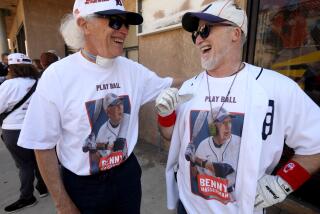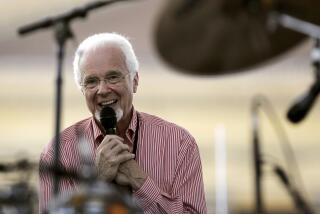Benny Goodman’s swing still holds sway
- Share via
For decades, Benny Goodman and his clarinet popped up just about everywhere, and when they did, just about everyone knew it.
Goodman, who would have turned 100 on May 30, defined for most people the swing era that dominated popular American music for much of the 1930s and 1940s.
From Carnegie Hall and New York’s exclusive clubs to his backing up Jack Teagarden in 1933 on “Texas Tea Party,” he was as versatile and prolific as he was famous.
“Goodman had a style that can be identified before his name is announced,” Ben Pollack, with whom Goodman first recorded in 1926, says in Nat Shapiro and Nat Hentoff’s 1955 classic book “Hear Me Talkin’ to Ya.”
Whether he was the greatest of his era is subjective, but he helped bring jazz out of smoky dives and into “respectable” (white) young America, to high school and college audiences and the American mainstream.
Goodman, who died of a heart attack in 1986 at age 77, relished the title “King of Swing” given him by the new white audiences who were largely unaware that black musicians, such as Louis Armstrong, were playing swing as far back as 1925.
“That some special thing, that style, that fluency he had lasted all the way through his career,” says Gunther Schuller, a composer, conductor and music historian whose books include “The Swing Era.”
Goodman launched careers and led the dissolution of the taboo against black and white musicians playing together. He hired some of the best black talent around, including Lionel Hampton and Teddy Wilson. They, Goodman and drummer Gene Krupa made up the wildly popular Goodman Quartet beginning in the 1930s.
When hotel owners or concert producers complained, they often were told, in effect, that when you hire Goodman you hire the whole band. Other bandleaders followed suit.
Some jazz writers say Artie Shaw may have been the better player. But in the public mind it is Goodman’s name that remains welded to swing.
“He was so constant you could pick him out from almost everything, at least from 1935 when he had his own bands. You know, ‘That’s Benny. Ain’t nobody else,’ ” Schuller says.
More to Read
The biggest entertainment stories
Get our big stories about Hollywood, film, television, music, arts, culture and more right in your inbox as soon as they publish.
You may occasionally receive promotional content from the Los Angeles Times.










